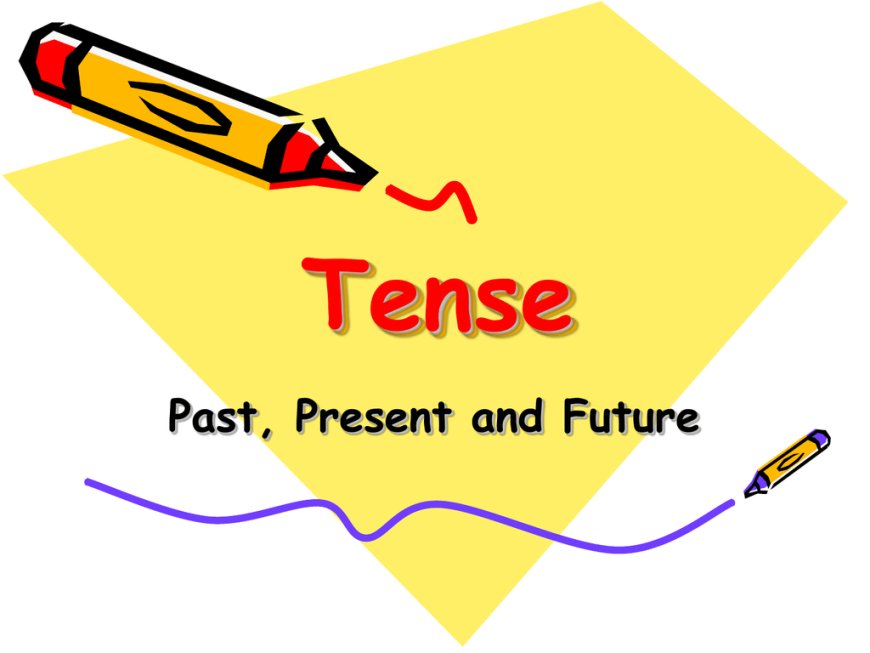The simple Tenses, Kinds, Uses and Structure

The Simple Tenses
Simple tense refers to the basic verb tenses used in English to indicate the time of an action or event. There are three simple tenses:
-
Simple Present Tense: It is used to describe actions or states that are generally true, habitual, or regular. In this tense, we use the base form of the verb (infinitive) for most subjects, but add 's' or 'es' for the third-person singular (he, she, it). Example: "She plays the piano every day."
-
Simple Past Tense: It is used to describe actions or states that occurred and were completed in the past. Regular verbs are formed by adding '-ed' to the base form of the verb, while irregular verbs have their own unique past tense forms. Example: "They watched a movie last night."
-
Simple Future Tense: It is used to describe actions or states that will happen in the future. In this tense, we use the auxiliary verb "will" or "shall" followed by the base form of the verb. Example: "I will call you tomorrow."
The Simple Present Tense:
The simple present tense in English is used to describe an action that occurs on a regular basis, habitual and to state universal truth.
Uses
Here are some key points about the simple present tense is used:
-
General facts and truths: The simple present is used to state facts that are generally true and not limited to a specific time. Examples: "Water boils at 100 degrees Celsius." "The Earth revolves around the sun."
-
Habits and routines: It is used to describe actions or behaviors that are regular or habitual. Examples: "I brush my teeth twice a day." "She goes for a run every morning."
-
Scheduled events: The simple present tense can be used to describe future events that are part of a fixed schedule or timetable. Examples: "The train departs at 9 a.m." "The concert starts at 7 p.m. tomorrow."
-
Repeated actions: It is used to express actions that are repeated or occur repeatedly. Examples: "She always arrives late for class." "They often visit their grandparents."
-
General truths about the future: The simple present tense can be used to express future events that are certain or part of a planned schedule. Examples: "The flight leaves tomorrow." "The conference takes place next week."
Structure
The structure of the simple present tense varies depending on the subject of the sentence. Here's the basic structure for affirmative, negative, and interrogative sentences in the simple present tense:
- Affirmative Sentences: Subject + Base Form of Verb (infinitive) [+ 's' or 'es' for third-person singular]
Examples:
- I play tennis.
- He eats an apple.
- They speak English.
- Negative Sentences: Subject + Do/Does + Not + Base Form of Verb (infinitive)
Examples:
- I do not play tennis.
- He does not eat an apple.
- They do not speak English.
- Interrogative Sentences: Do/Does + Subject + Base Form of Verb (infinitive)?
Examples:
- Do you play tennis?
- Does he eat an apple?
- Do they speak English?
Note: When forming questions in the simple present tense, we use the auxiliary verb "do" or "does" before the subject.
Additional points to consider:
- For the third-person singular (he, she, it), verbs usually take an 's' or 'es' at the end. This is not applied to other subjects.
- Negative sentences are formed by adding "not" after the auxiliary verb "do/does."
- To form short answers, we can use "yes" or "no" with the auxiliary verb. Example: "Do you play tennis?" "Yes, I do" or "No, I don't."
The Simple Past Tense:
The simple past tense is used to describe actions or events that occurred and were completed in the past.
Uses
The simple past tense is used to describe actions or events that occurred and were completed in the past. Here are some common uses of the simple past tense:
-
Completed actions: It is used to talk about actions that happened at a specific time in the past and are now finished. Examples: "I watched a movie last night." "She traveled to Paris two years ago."
-
Past habits or routines: The simple past tense can be used to describe actions or behaviors that were regular or habitual in the past but are no longer true. Examples: "He used to smoke, but he quit." "We always went camping during the summer when we were kids."
-
Narrating stories or events: The simple past tense is often used in storytelling to describe a sequence of past events. Examples: "Once upon a time, there was a brave knight." "She walked into the room and saw a surprise party."
-
Historical events: The simple past tense is used to talk about events or actions that took place in the past and are considered historical. Examples: "World War II ended in 1945." "Shakespeare wrote many famous plays."
-
Reported speech: When reporting something that was said or asked in the past, the simple past tense is used to reflect the original speaker's words. Examples: "She said, 'I will come tomorrow.'" "He asked, 'Did you see the movie?'"
-
Sequential actions: The simple past tense can be used to describe a series of past actions that happened one after another. Examples: "I woke up, brushed my teeth, and had breakfast." "They arrived at the airport, checked in, and boarded the plane."
-
Past states or conditions: The simple past tense can be used to talk about states or conditions that were true in the past. Examples: "She was happy yesterday." "They lived in that house for many years."
Structure
The structure of the simple past tense in English follows a consistent pattern. Here's the basic structure for affirmative, negative, and interrogative sentences:
- Affirmative Sentences: Subject + Past Form of Verb
Examples:
- I played tennis.
- She ate an apple.
- They spoke English.
In regular verbs, the past form is created by adding '-ed' to the base form of the verb (e.g., play → played, walk → walked). However, irregular verbs have their own unique past tense forms (e.g., eat → ate, speak → spoke).
- Negative Sentences: Subject + Did + Not + Base Form of Verb
Examples:
- I did not play tennis.
- She did not eat an apple.
- They did not speak English.
In negative sentences, we use the auxiliary verb "did" (the past tense of "do") before the main verb, followed by "not." The main verb remains in its base form (infinitive) without any changes.
- Interrogative Sentences: Did + Subject + Base Form of Verb
Examples:
- Did you play tennis?
- Did she eat an apple?
- Did they speak English?
In interrogative sentences, we use the auxiliary verb "did" at the beginning of the sentence, followed by the subject and the base form of the verb. The main verb remains in its base form without any changes.
Note:
- The past form of regular verbs is created by adding '-ed' to the base form, except for some irregular verbs.
- The auxiliary verb "did" is used in negative and interrogative sentences in the simple past tense, while the main verb remains in its base form.
- To form short answers, we can use "yes" or "no" with the auxiliary verb "did." Example: "Did you play tennis?" "Yes, I did" or "No, I didn't."
Simple Future Tense:
The simple future tense is used to describe an action that will happen in the future- immediate or on the spot decisions, itentions, promises, predictions without evidence.
Uses
The simple future tense is used to express actions or events that will happen in the future. Here are some common uses of the simple future tense:
-
Future plans and intentions: It is used to talk about future actions or events that are planned or intended. Examples: "I will go to the party tomorrow." "She is going to study abroad next year."
-
Predictions and assumptions: The simple future tense can be used to make predictions or express assumptions about the future based on current evidence or beliefs. Examples: "I think it will rain later." "They will probably arrive late."
-
Promises and commitments: It is used to express promises, commitments, or guarantees for future actions. Examples: "I will help you with your project." "He will definitely be there for the meeting."
-
Instant decisions: The simple future tense can be used to indicate instant decisions or actions made at the moment of speaking. Examples: "Oh, the phone is ringing. I will answer it." "I forgot my umbrella. I will buy one on the way."
-
Scheduled events: It is used to describe future events that are part of a fixed schedule or timetable. Examples: "The train will depart at 9 a.m." "The concert will take place next week."
-
Conditional statements: The simple future tense can be used in conditional statements to express hypothetical future outcomes. Examples: "If it rains, I will stay indoors." "I will buy a new car if I win the lottery."
-
Probability and speculation: The simple future tense can be used to express probability or speculation about future events. Examples: "He will probably win the race." "They might arrive early."
Structure
The structure of the simple future tense in English follows a consistent pattern. Here's the basic structure for affirmative, negative, and interrogative sentences:
- Affirmative Sentences: Subject + Will/Shall + Base Form of Verb
Examples:
- I will play tennis.
- She will eat an apple.
- They will speak English.
In affirmative sentences, the auxiliary verb "will" or "shall" is used before the base form of the main verb. The main verb remains in its base form (infinitive) without any changes.
Note: The choice between "will" and "shall" is primarily a matter of preference or regional usage. Both forms are generally interchangeable in modern English, although "shall" is less common in everyday conversation.
- Negative Sentences: Subject + Will/Shall + Not + Base Form of Verb
Examples:
- I will not play tennis.
- She will not eat an apple.
- They will not speak English.
In negative sentences, the auxiliary verb "will" or "shall" is followed by "not." The main verb remains in its base form without any changes.
- Interrogative Sentences: Will/Shall + Subject + Base Form of Verb
Examples:
- Will you play tennis?
- Will she eat an apple?
- Will they speak English?
In interrogative sentences, the auxiliary verb "will" or "shall" is used at the beginning of the sentence, before the subject. The main verb remains in its base form without any changes.
Note:
- "Will" is the most commonly used auxiliary verb to form the simple future tense.
- "Shall" is less common and typically used with first-person pronouns ("I" and "we") to indicate future actions or offer suggestions.
- To form short answers, we can use "yes" or "no" with the auxiliary verb. Example: "Will you play tennis?" "Yes, I will" or "No, I won't."
Exercise on Simple Tense
- She __________ (cook) dinner every evening.
- I __________ (visit) my grandparents last weekend.
- We __________ (live) in that house for five years.
- They __________ (read) books regularly.
- He __________ (write) a letter to his friend yesterday.
- My sister __________ (study) law at the university.
- We __________ (go) to the beach yesterday.
- They __________ (play) soccer every Saturday.
- He __________ (watch) a movie last night.
- The sun __________ (rise) in the east.
Answers:
- cooks
- visited
- lived
- read
- wrote
- studies
- went
- play
- watched
- rises
What's Your Reaction?


























































